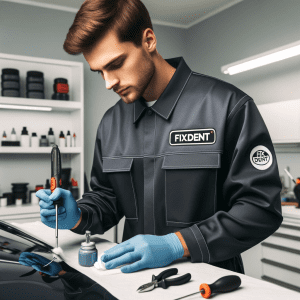Your car has taken you on a captivating journey through varied landscapes and urban jungles, but sometimes, it also brings back unexpected “souvenirs” on its bodywork – undesirable dents and scratches. This is where the Paintless Dent Repair (PDR) technique comes in, a revolutionary method to restore your vehicle to its original shine without the need for long workshop stays or expensive repairs. However, when it comes to car insurance, many owners wonder: is this convenient method covered by their insurance policy? This article will reveal everything you need to know about PDR and car insurance, enabling you to make an informed decision when your car needs that special care, known as TLC (Tender Loving Care).
The Basics of PDR

PDR, or Paintless Dent Repair, is a technique that allows specialists to remove small dents and deformations from the car’s bodywork without the need for filling, painting, or long drying times. This process involves using special tools and techniques to push the metal from the back forward, thus restoring the original shape of the surface without damaging the factory finish.
The benefits of PDR are numerous and appreciated by both vehicle owners and insurance companies. Firstly, the method is significantly faster than traditional dent repair. In many cases, PDR can be completed in less than a day, meaning you can get back on the road quickly and effortlessly. Additionally, as painting is not required, there is no risk of color mismatch, ensuring your car looks new after the repair. Lastly, PDR is an environmentally friendly alternative as it avoids the use of chemicals and materials associated with traditional repair.
While PDR may seem like the ideal solution for all types of dents, it’s important to note that the method is most effective under certain conditions. Dents should be small to medium-sized, without paint chipping or sharp edges. The location of the dent also plays a role – hard-to-reach places can pose a challenge for PDR technicians.
Now that we understand the basics of PDR, let’s look at how this method fits into the framework of car insurance and how you can make the most of your policy if you need a dent repair.
When considering PDR as a repair option, it is crucial to keep in mind that this method is not suitable for all types of damage. A large dent from a car accident or deep scratches that have penetrated the paint usually require a more traditional repair approach. However, for most surface dents caused by hail, light collisions with shopping carts, or accidental bumps from opening doors, PDR remains the gold standard.
Car Insurance and PDR


In this section of our article, we will take a closer look at the relationship between PDR (Paintless Dent Repair) and car insurance. When damage occurs to your vehicle, the first step is to determine if it is covered by your insurance. Most insurance policies cover dent repairs resulting from unforeseen events such as hail or vandalism. It is important to note that some policies may include PDR as standard coverage, while others may require an additional extension of coverage or have specific conditions for its use.
To find out if your case is covered, you will need to carefully review your insurance policy or contact your insurance company directly. It is crucial to ask specific questions regarding PDR coverage and understand the steps to file a claim.
One of the main advantages of PDR in the insurance context is that the method is often less expensive than traditional repair. This can mean lower costs for the insurance company itself and a lesser likelihood that you will have to pay a deductible for the repair. Moreover, as PDR preserves the original paint of the car, it can help maintain your vehicle’s market value, an important aspect when selling or exchanging.
To move from theory to practice, let’s see what you need to do if you require PDR and how to approach your insurance company. The first step is to contact them as soon as you notice the damage. It is important to do this before undertaking any repair measures, as some insurers may have specific requirements for the damage assessment process and the choice of repair shop.
Your insurance company may ask you to take photos of the damage and provide a detailed description of the incident, as well as fill out certain claim forms. They may also decide to send an assessor to inspect the car on site, or ask you to take it to an approved workshop for an evaluation.
It is essential to be prepared with all the necessary documents, including the insurance policy, vehicle registration documents, and any other evidence that could be useful. Additionally, if you have already chosen a PDR specialist, it may be necessary to inform them of the insurance process, so they are also aware of any potential requirements or restrictions from the insurer.
Once the insurance company has processed your request and approved the use of PDR, you can proceed with the repair. It is important to note that in some cases, you might have to cover the deductible, depending on the terms of your policy, so be prepared for this potential expense.
With an understanding of these steps and proper preparation, the process of filing a claim for PDR can be smooth and lead to a quick and efficient restoration of your vehicle, with or without the involvement of your insurance.




